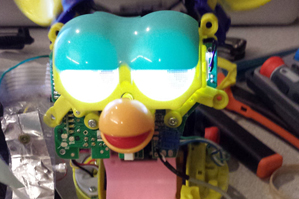How does Furby do it?

What do you do in your spare time? Personally, I’ve been reading Game of Thrones and re-covering my couch cushions. Others play sports or watch movies. But I know of only one person who reverse engineers Furby dolls when he’s got some down time.
Yes, you read the right. Michael Coppola, CIS ’15, a computer science student set to graduate at the end of 2014, spent much of his semester dissecting one of these intelligent plush toys. The idea, part of a directed study with CCIS assistant professor William Robertson, was to isolate the microchips on the Furby’s circuit board, look at the chips under very high magnification, and look into the circuitry that betrays all of the Furby’s magical mysteries.
After he disassembled the doll and got to the circuit board, he discovered that the chips were covered in an opaque, unbreakable epoxy. “The company is trying hard to keep their designs secret,” he said. Which is perhaps not all that surprising. What is surprising, at least to me, is what Coppola did next.
Working with chemistry professor Geoff Davies, Coppola managed to dissolve the epoxy using nitric acid and a few other toxic ingredients. There’s a recipe for doing this sort of thing, he told me, but not many people have access to the resources and equipment necessary.
After isolating the chips from the epoxy, he said, they were no longer functional. Next, he worked with William Fowle, the facilities manager for the EM laboratory, to get high resolution images of the chips, blowing up images of that circuitry to about 700 times its original size. As Coppola explained, “memory chips store information encoded as a series of peaks and valleys, bumps and divots that you can decode into binary.”
So, the magnified images he got essentially gave him the secret blueprints that Hasbro uses to give the neon Gremlin-wannabes their own personalities and the ability to communicate with one another.
You can read more about Coppola’s project on his blog, poppopret.org.





